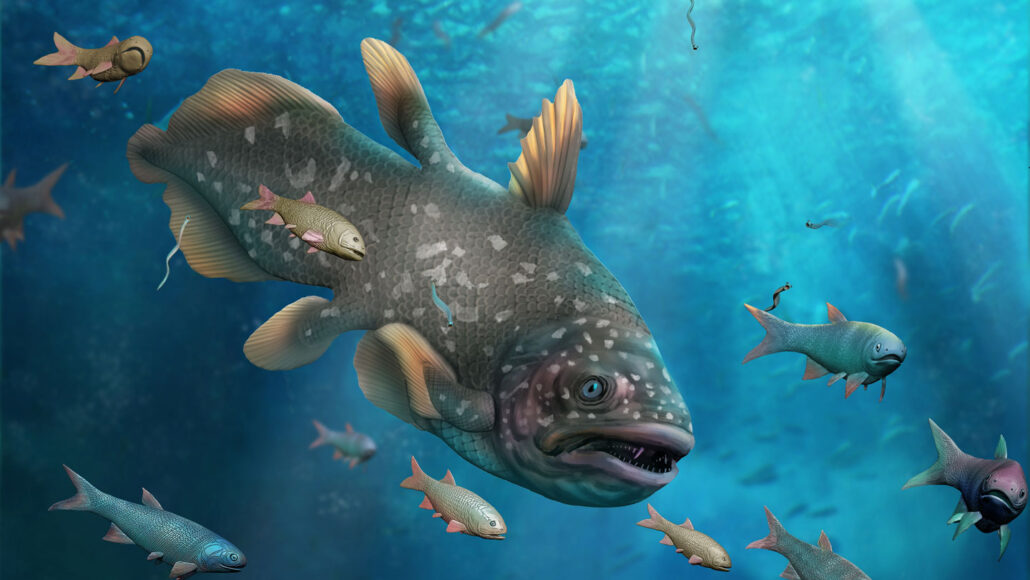Ocean life may have bounced back after the ‘Great Dying’
Fossil creatures date to just a million years after the Earth’s deadliest mass extinction

The Guiyang biota is a collection of fossils found in South China. It contains the remains of a diverse marine ecosystem (illustrated). That creature community included large, predatory fish known as coelacanths and eel-like conodonts.
Dinghua Yang, Haijun Song
By Nikk Ogasa
After the most severe mass extinction known, vibrant marine ecosystems may have recovered within just a million years. That’s millions of years faster than previously thought. The evidence lies in a diverse trove of pristine fossils discovered in South China. Those creatures may be the early foundations of today’s ocean ecosystems.
The Permian-Triassic mass extinction is known as the Great Dying. It occurred around 251.9 million years ago, at the end of the Permian Period. The accepted story was that the ocean was kind of dead for millions of years after this mass extinction, says Peter Roopnarine. “Well, that’s not true. The ocean [was] very much alive.” A paleontologist, Roopnarine works at the California Academy of Sciences in San Francisco. He was not involved in the new study.
The Great Dying happened after a series of massive volcanic eruptions. “The oceans warmed significantly,” Roopnarine says. There’s evidence for acidic waters and widespread dead zones starved of oxygen. And creatures may have been poisoned. “There [were] a lot of toxic elements entering into parts of the ocean,” he says.
Life in the seas suffered. More than 80 percent of marine species went extinct. Some researchers have even proposed that entire levels of the food web may have vanished.
Figuring out how long life took to recover in the wake of all that loss has been challenging. Researchers have found clues in groups of fossils. In 2010, researchers were studying fossils from one of these groups, called the Luoping biota, from China. They proposed that complex marine ecosystems fully rebounded within 10 million years. Later, other fossil finds changed the picture. That includes the Paris biota in the western United States and the Chaohu biota in China. These led scientists to suggest that marine ecosystems revived within just 3 million years.
Then in 2015, a lucky discovery narrowed the gap again. Paleontologist Xu Dai was then an undergraduate student. He was at the China University of Geosciences in Wuhan. While studying rocks from the early Triassic Period during a field trip near the city of Guiyang, he split a piece of black shale. Within the rock, he discovered a surprisingly well-preserved fossil. It would later be identified as a primitive lobster.
The lobster’s immaculate condition sparked a series of return trips. Dai now works at the University of Burgundy in Dijon, France. From 2015 to 2019, he and his colleagues uncovered a cache of fossilized life: Predatory fish as long as baseball bats. Ammonoids in swirled shells. Bivalves in hinged shells. Eel-like conodonts. Early shrimps. Sponges. Fossilized poo.
Life on the rebound
This collection became known as the Guiyang biota. And it kept offering prizes. Under and within the fossil trove, Dai and his colleagues discovered beds of volcanic ash. An analysis of the amounts of uranium and lead in the ash revealed the Guiyang biota’s age. These fossils were from roughly 250.7 to 250.8 million years ago. The dating also fits with the types of fossils found and the rocks’ different forms of carbon. The researchers shared their findings in the February 10 Science.
Finding a potpourri of life of this age suggests that marine life rebounded quickly after the Great Dying, within just 1 million years or so, Dai says.
But the find could have other explanations instead. It may indicate that the extinction event failed to wipe out entire food web levels, says William Foster. A paleontologist, he works at the University of Hamburg in Germany. He was not part of the study. “You have this really environmentally stressful world. But some former marine ecosystems survive.”
And these ecosystems of the early Triassic were hardy. At that time, some 250 million years ago, the community preserved in the Guiyang biota was located in the tropics. The temperature of the sea surface was nearly 35⁰ Celsius (95⁰ Fahrenheit). And past research had suggested many organisms may have migrated away to flee the heat. But, the discovery of the Guiyang biota challenges that, Foster says. Sea creatures tolerated it somehow. They adapted, he says.
According to Dai, the fossils suggest that the roots of today’s marine ecosystems took hold soon after the Great Dying. “These groups are related to modern fish, lobsters and shrimps, their ancestors,” he says. “The oldest time we can find similar seafood to today is [in the time of] the Guiyang biota.”
But Roopnarine is skeptical. It’s not clear how the Guiyang biota connects to today’s ecosystems, he says. These fossils could represent a short-lived collective rather than a stable community. After all, ammonoids and conodonts went extinct, he points out.
Future work will help answer the many questions unearthed with the Guiyang biota, Dai says. His team plans to head back into the field this summer for the first time since 2019. When asked if he’ll be keeping his eyes peeled for another lobster, he responds: “Of course.”







